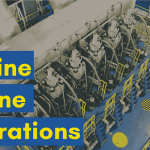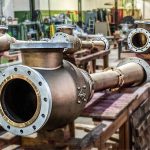One of the most important items of equipment aboard ships, boilers are used for numerous purposes. This article describes the construction and working of a marine boiler.
Whether it is steam powered or has a diesel engine as the main form of propulsion, a ship without a boiler is really difficult to imagine; a boiler, in one form or another will be found on a ship. For example if a ship is a steam powered ship, two or more boilers will be provided to produce high temperature, high pressure steam. If a ship is carrying a diesel engine as the main propulsion system, one or two smaller boilers are used for running various ship’s machinery and services. So let us find out how boilers work and learn about their construction.
How do Boilers Work?
A basic boiler is a machine with the simplest arrangement of the internal parts. The main job of a boiler is to make high pressure steam. The feed water supplied to the boiler drum utilizes the heat of the energy released by burning the fuel. This energy of the burning fuel is stored in the form of steam with high temperature and pressure. The fuel is burnt in a combustion chamber inside the boiler. To attain high efficiency and complete combustion, air is supplied to this combustion chamber through a separate arrangement. The heat generated in this combustion chamber is transferred to the water from the boiler drum through a large surface area, which enables the highest rate of energy transfer.
The Steam Generation Process
The process of steam generation starts when the feed water enters the steam drum through both internal tubes and the tubes that surround the furnace. The system of tubes that surrounds the furnace are known as waterwall or floor tubes. The feed water gets heated when passed through these tubes. Addition to this, there are Large-bore downcomer tubes that passes outside of the furnace and are used to circulate water between the drums, to which the tubes are attached from outside of the furnace.
The steam produced in the steam drum is known as wet or saturated steam. This steam cannot be used directly as it contains high amounts of moisture. To make this steam usable, it is first dried and heated with the help of a superheaterlocated within the boiler. Once all the moisture content is removed from the steam, the superheated steam can be supplied to other systems. It is utmostly important to monitor and control the temperature of the superheated steam, or else it can cause damage to the systems to which it is supplied. For this reason, an implement known as an attemperator is used. The attemperator is a kind of cooler which is used to cool down the superheated steam to the right temperature. Thus, all the steam used in various system is taken out from the main steam drum of the boiler.
The energy from the fuel burning are used for various other purposes, the main two are as follows:
· For heating feed water to produce steam
· For superheating the steam from the boiler drum
To increase the efficiency of the boiler, the feed water that enters the boiler is pre-heated with the help of an economizer through which the feed water passes before entering the boiler. The exhaust gas of the boiler is also put to use by making it pass over an air heater, which heats up the combustion air entering the furnace. Thus, even the energy exhausted from the boiler is not allowed to go waste, which increases the overall efficiency of the system.
All these boilers are fitted with various safety fittings and control systems to monitor and control various aspects such as fuel oil flow rate, flow of combustion air, and feed water supply. All these systems should work in co-ordination to supply the amount of steam required by various system. The boiler is also provided with various mountings to ensure safe operation of the boiler.
Types of Boilers
There are two main types of boilers. These are known as the basic boilers, the rest all are different versions of them. The main two basic boilers are:
· Water tube boiler
· Fire tube boiler
The design and arrangement of both the types is just the opposite. In water tube boilers, the feed water passes through the tubes and the hot gases are made to pass over them, while in fire tube boilers, the hot gases passes through the tubes and the feed water surrounds them.



Comments are closed